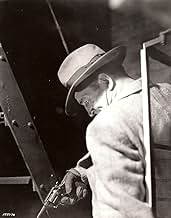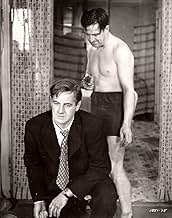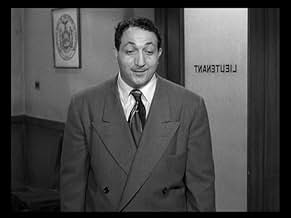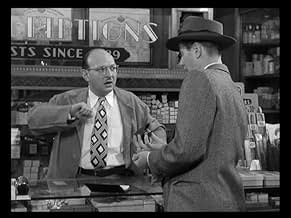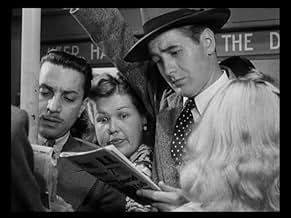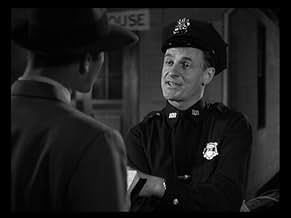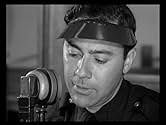IMDb-BEWERTUNG
7,5/10
16.504
IHRE BEWERTUNG
Ein Schritt-für-Schritt-Blick auf eine Morduntersuchung auf den Straßen von New York.Ein Schritt-für-Schritt-Blick auf eine Morduntersuchung auf den Straßen von New York.Ein Schritt-für-Schritt-Blick auf eine Morduntersuchung auf den Straßen von New York.
- 2 Oscars gewonnen
- 6 Gewinne & 5 Nominierungen insgesamt
Ted de Corsia
- Willy Garzah
- (as Ted De Corsia)
Mark Hellinger
- Narrator
- (Synchronisation)
Jean Adair
- Little Old Lady
- (Nicht genannt)
Celia Adler
- Dress Shop Proprietress
- (Nicht genannt)
Janie Alexander
- Girl
- (Nicht genannt)
Joyce Allen
- Shopgirl
- (Nicht genannt)
Beverly Bayne
- Mrs. Stoneman
- (Nicht genannt)
Empfohlene Bewertungen
THE NAKED CITY is like watching a time capsule unfold of New York City in the late '40s--the cars, the subways, the bridges, the people bustling along busy streets totally unaware of filming (scenes were shot from cars with tinted windows and two-way mirrors), and at the center of it all is a rather routine detective story. But the difference is the style that director Jules Dassin gets out of his material, giving the drama a chance to build up the proper tension before the final shootout on city streets and bridges.
BARRY FITZGERALD is the detective with the very helpful sidekick DON TAYLOR, a young police officer from Queens who helps him track down the man responsible for the death of a pretty blonde in what the tabloids called "The Bathtub Murder". Both men are excellent as they follow a batch of clues to get to the bottom of the crime. HOWARD DUFF is also excellent as a man mixed up in the robberies, with DOROTHY HART as his unsuspecting sweetheart.
TED DeCORSIA, making his film debut, is the athletic villain, working out in his small apartment when detective Taylor finds him--but soon making his escape which leads to the film's most breathtaking moments of a dazzling chase that fills the last ten minutes with high tension suspense.
The crime itself is not that interesting, but the style used to tell the tale (with a voice-over narration telling us at the conclusion that this is just one story in a city of millions) is what makes it far superior to most detective stories. That and the fact that New York City is given the spotlight for location photography that really hits the mark.
BARRY FITZGERALD is the detective with the very helpful sidekick DON TAYLOR, a young police officer from Queens who helps him track down the man responsible for the death of a pretty blonde in what the tabloids called "The Bathtub Murder". Both men are excellent as they follow a batch of clues to get to the bottom of the crime. HOWARD DUFF is also excellent as a man mixed up in the robberies, with DOROTHY HART as his unsuspecting sweetheart.
TED DeCORSIA, making his film debut, is the athletic villain, working out in his small apartment when detective Taylor finds him--but soon making his escape which leads to the film's most breathtaking moments of a dazzling chase that fills the last ten minutes with high tension suspense.
The crime itself is not that interesting, but the style used to tell the tale (with a voice-over narration telling us at the conclusion that this is just one story in a city of millions) is what makes it far superior to most detective stories. That and the fact that New York City is given the spotlight for location photography that really hits the mark.
...New York! This film is presented as a quasi-documentary (it is not). Though the story is fictional, the setting is entirely real - 1948 New York City. And that is the biggest appeal of the picture (I was born and raised there so I may be biased). Some interior shots appear to have been filmed on a sound stage, but the bulk of it is on location. For example, there is a scene filmed in lower Manhattan near Rivington and Norfolk streets. It show's a bustling, thriving "family" neighborhood with well dressed folks and kids playing in the neighborhood. It looks nothing like that now - just a place to pass through to get to somewhere else (though there is a school there now - check google maps and find the intersection - you can see the same building in the opening shot for that scene).
Story-wise, it's a pretty solid film especially considering how dated movies from this period can be. There appears to be a real attempt to make the movie as accurate as possible and goes out of its way to include the methods used in solving modern crimes such as forensics - probably a novelty at the time. The acting is solid throughout. I'm not sure how comfortable I am with the idea of a narrator - on the one hand, it lends authenticity to the documentary feel, but on the other, it can take you "out" of the picture at times. Overall, very worth watching. I give it a thumbs up (can I do that here?)
Story-wise, it's a pretty solid film especially considering how dated movies from this period can be. There appears to be a real attempt to make the movie as accurate as possible and goes out of its way to include the methods used in solving modern crimes such as forensics - probably a novelty at the time. The acting is solid throughout. I'm not sure how comfortable I am with the idea of a narrator - on the one hand, it lends authenticity to the documentary feel, but on the other, it can take you "out" of the picture at times. Overall, very worth watching. I give it a thumbs up (can I do that here?)
That's just what the producer, Mark Hellinger does. He tries to make it clear from the introduction that this is not your average movie. It is not. This entire production tries to accomplish one thing - authenticity. And for the most part, it succeeds.
Before I get to what's right about this movie, let me mention a few of the things that are wrong. Ted DeCorsia overacts. He always overacts. Howard Duff's character, Frankie Niles, is supposed to be a streetwise grifter. How the hell could he be dumb enough to get himself in as many pickles as he did. Anybody who has ever been around the block would know better than to lie to the cops about everything. Just lie about the important things and tell the truth when it won't hurt you. If this guy is a sociopath, he's the dumbest one in town. Although most of the accents are on the money, the incidental dialogue injected into some of the scenes sounds forced and phony. In fact, it sounds like Hollywood trying to sound like New York. Mark Hellinger's narration, by comparison, is not only authentic, it's practically Damon Runyonesque.
Now - what's right. Practically everything else. The location photography is the New York I remember as a kid. While I was watching some of the hot summer scenes downtown, I could practically smell the asphalt, melting tar, and garbage. Don Taylor's brick duplex in Queens was just the kind of house that every struggling family on the wrong side of Brooklyn aspired to.
I won't comment on the story except to say, it's an entirely believable crime story. I seem to remember Barry Fitzgerald playing a similar role in Union Station. Reminds one of the old days when most of the cops were Irish - and New York was really New York.
Before I get to what's right about this movie, let me mention a few of the things that are wrong. Ted DeCorsia overacts. He always overacts. Howard Duff's character, Frankie Niles, is supposed to be a streetwise grifter. How the hell could he be dumb enough to get himself in as many pickles as he did. Anybody who has ever been around the block would know better than to lie to the cops about everything. Just lie about the important things and tell the truth when it won't hurt you. If this guy is a sociopath, he's the dumbest one in town. Although most of the accents are on the money, the incidental dialogue injected into some of the scenes sounds forced and phony. In fact, it sounds like Hollywood trying to sound like New York. Mark Hellinger's narration, by comparison, is not only authentic, it's practically Damon Runyonesque.
Now - what's right. Practically everything else. The location photography is the New York I remember as a kid. While I was watching some of the hot summer scenes downtown, I could practically smell the asphalt, melting tar, and garbage. Don Taylor's brick duplex in Queens was just the kind of house that every struggling family on the wrong side of Brooklyn aspired to.
I won't comment on the story except to say, it's an entirely believable crime story. I seem to remember Barry Fitzgerald playing a similar role in Union Station. Reminds one of the old days when most of the cops were Irish - and New York was really New York.
This is a great Film Noir movie which I enjoyed very much. My favorite part is watching all the 100's of people on the streets on New York City not having a clue that the are immortalized in this motion picture. I love to freeze frame the street scenes and view how life was like in 1948. So many surprises, for example in the phone booth scene, notice the two men peering out the window in the store across the street. I think those guys were aware of the filming, but as the scene continued, they went back to serving their customers. Just plain magic. There is also a cool goof in this film. Note during the train station chase scene, just after Frank runs by, the director or a film crew member turns towards the camera and yells what I believe is "CUT"...So Fun....I'll see again and again and again!
An unrealized project of Alfred Hitchcock's was to make a movie about 24 hours in the life of a great city, probably New York. Producer Mark Hellinger enlisted director Jules Dassin to attempt a similar stunt. The result was The Naked City, a slice-of-life police procedural that served as template for the popular television series a decade later. And while the movie is nowhere near the ground-breaking cinematic enterprise that Hellinger promises in his introduction and ceaseless voice-over narration, it's not negligible. With its huge cast (many of them recognizable, even in mute or walk-on roles) and pioneering location shooting on the sidewalks of New York during the sweltering summer of 1947, it nonetheless continues to satisfy. Its documentary aspect outlives its suspense plot.
It opens with two men chloroforming and then drowning a high-profile model in her city apartment (shades of I Wake Up Screaming and Laura). When her cleaning lady finds her next morning, it falls to Detective Lieutenant Barry Fitzgerald, with his heather-honey lilt, and his principal investigator, Don Taylor, to fit the pieces together. Soon into their web flits Howard Duff, an affable, educated loafer with no visible means of support who lies even when the truth would do him no harm. It seems he was on cozy terms with the deceased, even though he's engaged to one of her co-workers (Dorothy Hart). But although Duff's a poor excuse for a human being, nothing seems to stick to him, either. So the police slog on through the broiling day and soupy night, knocking on doors and flashing pictures of the dead girl. Their sleuthing takes them, and us, up and down the hierarchy of the city's eight million souls, from society dames and society doctors to street vendors and street crazies.
While the plot never rises out of the routine, these urban excursions give the movie its raffish texture and remain one of its chief pleasures. This was New York in the dawn of its post-war effloresence, a city where it was still common practice to live comfortably on modest average wages. The gap between East Side apartments and Lower East Side walkups, with the bathtub in the kitchen, doesn't yet seem impossible to cross. And its inhabitants burst on camera with a welter of accents and attitudes. Hellinger and Dassin must have enlisted the services of every character-actor and bit-player in the Tri-State area, and film buffs will have a trivia tournament in trying to pick them out.
The Naked City ends with a chase over hot pavements and a stand-off high up on one of the bridges spanning the East River. It's a great set-piece, of the sort that action movies are all but required to include, but the movie's strength proves more subtle it lies in its collection of sharply drawn vignettes (some of them, to be sure, little more than sentimental shtik). The Naked City is a rarity a major production where the day players outshine the stars.
It opens with two men chloroforming and then drowning a high-profile model in her city apartment (shades of I Wake Up Screaming and Laura). When her cleaning lady finds her next morning, it falls to Detective Lieutenant Barry Fitzgerald, with his heather-honey lilt, and his principal investigator, Don Taylor, to fit the pieces together. Soon into their web flits Howard Duff, an affable, educated loafer with no visible means of support who lies even when the truth would do him no harm. It seems he was on cozy terms with the deceased, even though he's engaged to one of her co-workers (Dorothy Hart). But although Duff's a poor excuse for a human being, nothing seems to stick to him, either. So the police slog on through the broiling day and soupy night, knocking on doors and flashing pictures of the dead girl. Their sleuthing takes them, and us, up and down the hierarchy of the city's eight million souls, from society dames and society doctors to street vendors and street crazies.
While the plot never rises out of the routine, these urban excursions give the movie its raffish texture and remain one of its chief pleasures. This was New York in the dawn of its post-war effloresence, a city where it was still common practice to live comfortably on modest average wages. The gap between East Side apartments and Lower East Side walkups, with the bathtub in the kitchen, doesn't yet seem impossible to cross. And its inhabitants burst on camera with a welter of accents and attitudes. Hellinger and Dassin must have enlisted the services of every character-actor and bit-player in the Tri-State area, and film buffs will have a trivia tournament in trying to pick them out.
The Naked City ends with a chase over hot pavements and a stand-off high up on one of the bridges spanning the East River. It's a great set-piece, of the sort that action movies are all but required to include, but the movie's strength proves more subtle it lies in its collection of sharply drawn vignettes (some of them, to be sure, little more than sentimental shtik). The Naked City is a rarity a major production where the day players outshine the stars.
Wusstest du schon
- WissenswertesMost of the street scenes were shot on location in New York without the public's knowledge. Photographer William H. Daniels and his uncredited assistant Roy Tripp filmed people on the streets using a hidden camera from the back of an old moving van. Occasionally, a fake newsstand with a hidden camera inside was also set up on the sidewalk to secretly film the actors. Director Jules Dassin hired a juggler to distract the crowds and also hired a man to occasionally climb up on a light post and give a patriotic speech, while waving an American flag to get the crowd's attention.
- PatzerDuring the end pursuit, Garzah walks past a plump, dark-haired lady in a floral dress, pushing a baby in a stroller. As Donahue pursues in a following scene, he passes the same woman, now walking without her baby carriage and her left hand bandaged.
- Crazy CreditsThe opening credits are spoken by producer/narrator Mark Hellinger. No credits are seen on the screen.
- VerbindungenFeatured in The Movie Orgy (1968)
- SoundtracksSobre las Olas (Over the Waves)
(1887) (uncredited)
Written by Juventino Rosas
Background music for the girls on swings
Top-Auswahl
Melde dich zum Bewerten an und greife auf die Watchlist für personalisierte Empfehlungen zu.
- How long is The Naked City?Powered by Alexa
Details
- Erscheinungsdatum
- Herkunftsland
- Sprache
- Auch bekannt als
- La ciudad desnuda
- Drehorte
- Produktionsfirmen
- Weitere beteiligte Unternehmen bei IMDbPro anzeigen
Box Office
- Bruttoertrag in den USA und Kanada
- 2.400.000 $
- Laufzeit
- 1 Std. 36 Min.(96 min)
- Farbe
- Seitenverhältnis
- 1.37 : 1
Zu dieser Seite beitragen
Bearbeitung vorschlagen oder fehlenden Inhalt hinzufügen


